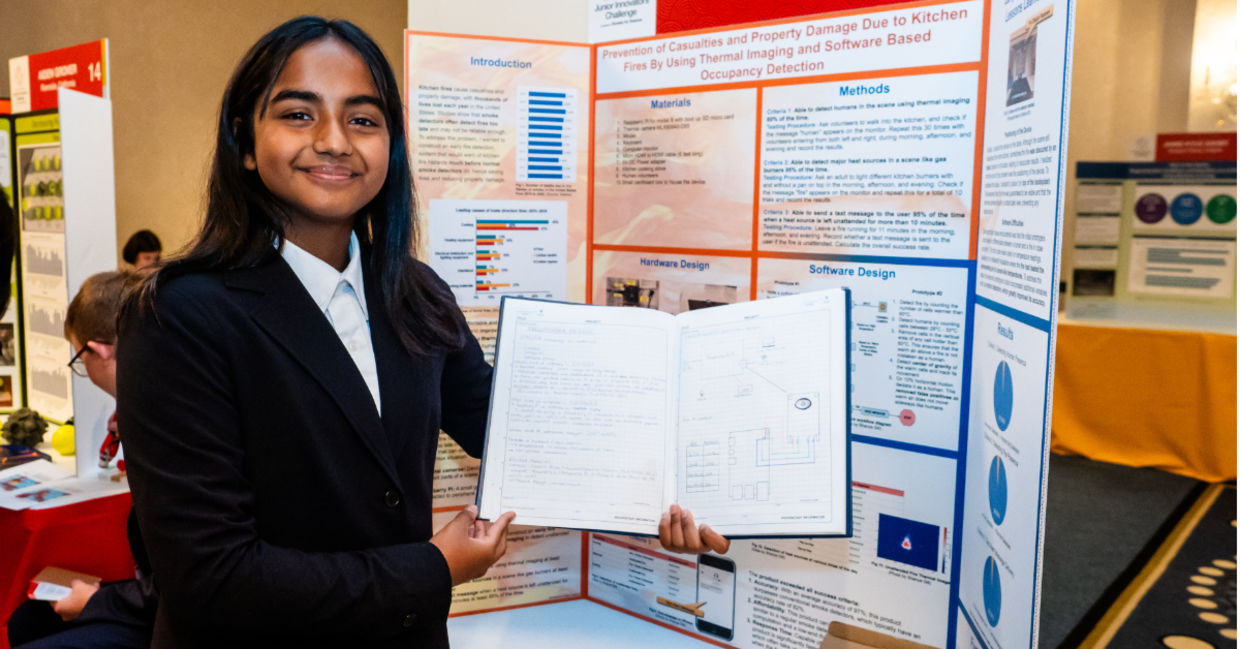
(Jessica Yurinko/Society for Science)
Winning a prestigious science award is a really big deal. Especially if you are only 12-years-old. But Shanya Gill, a middle schooler from San Jose, California, won the top award in the Thermo Fisher Scientific Junior Innovators Challenge for designing a fire detection system that is superior to existing ones, according to a press release from the organization.
Thermo Fisher is the country’s premier STEM competition and reaches 65,000 middle schools from across the US. There are 30 finalists – from the nearly 2,000 applicants – that competed in the Washington DC awards ceremony on November 1.
“The top winners of the Thermo Fisher Scientific Junior Innovators Challenge have exhibited boundless curiosity,” Maya Ajmera, president and CEO of Society for Science and the executive publisher of Science News Media Group, said in the press release. “Their remarkable research not only reflects their talent but also paves the way for an exciting new future.”
The inspiration behind Shayna’s project
Shanya’s inspiration came after a fire destroyed a restaurant in her neighborhood during the summer of 2022, reported The Washington Post.
“I had never really experienced something like that before,” she told Washington Post, about the early morning fire at Holder’s Country Inn, which started in the kitchen. “They had smoke detectors, and yet it still burned down,” she added.
After she studied fire statistics and saw how prevalent fires are, Shanya a decided that she was going to do something about it.
She spent more than a year developing a fire detection system that she believes could have prevented the fire. That’s because smoke detectors sense active fires from the smoke in the air. Shanya’s thermal imaging device is designed to stop fires from occurring.
Her sophisticated system has two parts, a thermal camera and a Raspberry Pi, a tiny computer. The device detects when a heat source has been left unattended for ten minutes and sends a text message alert.
Creating the prototype was difficult and the hardest part was the coding. “I had two designs, and my first design completely failed. It was a really big barricade I had to go through, she said”
The final device outperforms smoke detectors in speed and accuracy. Shanya wants to bring the costs down to $60 to make it even more affordable than hardwired smoke detectors.
“Shanya saw a problem and she went after it and tried to solve it, and that’s what we need to encourage with all young people,” said Ajmera, “Research shows that many young people drop out of STEM, especially girls and kids of color.”
The other top finalists
All of the finalists were chosen from a panel of scientists, engineers, and teachers, according to the press release. There were five top award winners as well as first and second prize winners in STEM categories.
The Broadcom Coding with Commitment™ Award was won by 14-year-old Keshvee Sekhda from Sugar Hill, Georgia for her combining coding with STEM to approve communities that are in sync with the 17 Sustainable Development Goals of the United Nations.
Maya Gandhi, a 14-year-old from Anaheim, California was the DoD STEM Talent Award winner for her project that explored substances to boost energy output of plant microbial fuel cells that can generate electricity.
Adyant Bhavsar, a 13-year-old from San Jose, California was awarded the Lemelson Award for Invention from The Lemelson Foundation by creating an eco-friendly and low-cost triboelectric nanogenerator that created electricity.
Robert Wood Johnson Foundation Award for Health Advancement (a health award) was awarded to 13-year-old Elizabeth Olvera from Goleta, California for finding an eco-friendly material that can be used for reusable hygiene pads.
All of these amazing young people have potential for careers in STEM. Awards like these help to keep young people involved in science and engineering. Who knows how far they can soar.
YOU MIGHT ALSO LIKE:
This 13-Year-Old is Headed to Med School
HS Student Designs Self-Activating Home Fire Suppression Device
This Smart Teen Invented Color-Changing Sutures to Detect Infection







